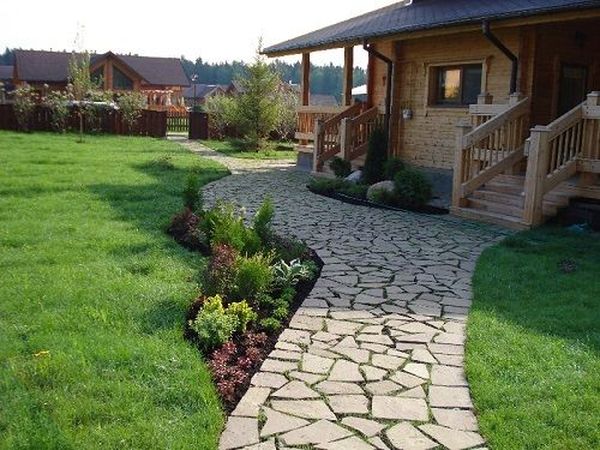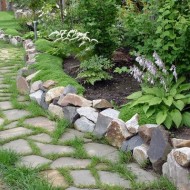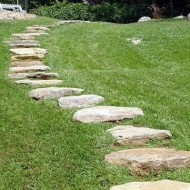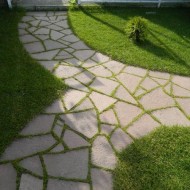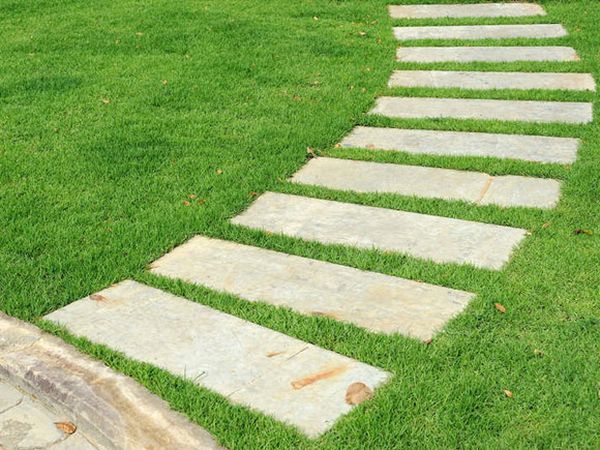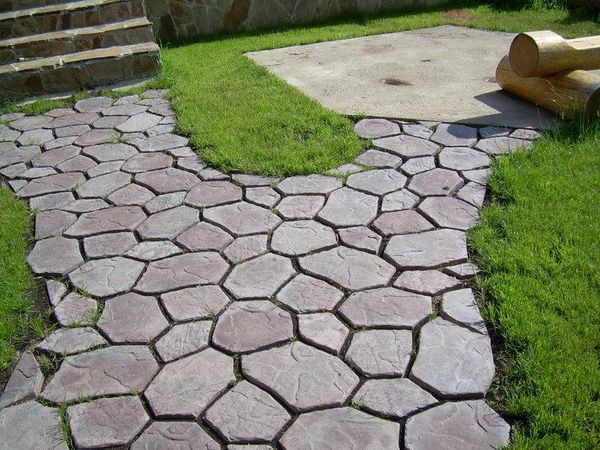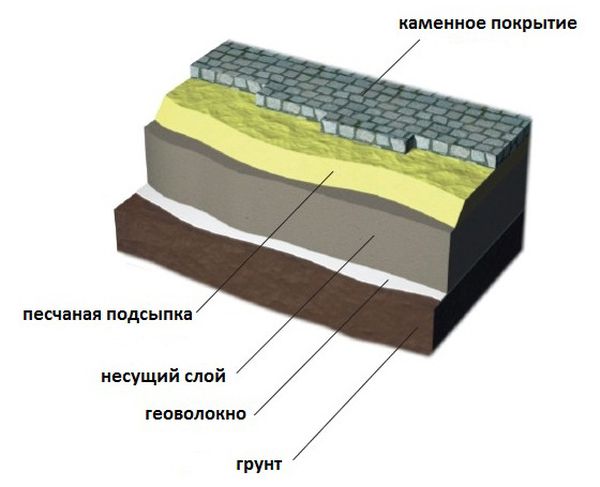Garden paths made of stone - natural beauty at their summer cottage
Content
Types of stone
Natural stone is considered the best material for landscaping, although you cannot call it cheap. It is easy to resolve the obvious contradiction if you remember that the stone-paved paths in the garden will serve not for years, but for decades, without requiring repairs, withstanding serious loads and withstanding the harsh domestic climate.
Several types of natural stone are used in construction:
- Slate. It has a layered structure, the material is easily split into flat plates, the thickness of which varies. The plates are small in size, which makes work easier. Quartzite slate is suitable for paths. You should not purchase a material with high porosity, its performance properties are much worse.
- Granite. The most durable and durable among the rest, it will serve for several centuries. The color of the material depends on the quantitative composition of the spar present in it, it can range from dark red to gray. He is not afraid of either the scorching rays of the sun, or snow, or rain.
- Quartzite. Difficult to process, when changing lighting it is able to change the tone of the color. Handsome, lasts a long time.
- Shungite. The colors are dull, ranging from gray to black. If you find a material interspersed with quartz, you can lay out tracks with certain patterns in white or gold. Not afraid of frost, withstands very heavy loads. It is found with a monolithic and layered structure.
- Sandstone. The cheapest, and therefore the most demanded material. Not as strong as granite, but it will still serve for many decades. Easy to handle. There are stones of different shades on sale: green, pink, brown, yellow, etc.
When choosing a stone of a particular breed, be sure to pay attention to its type:
- paving stones and sawn stone of the same shape and dimensions;
- cobblestones, boulders and flagstone - their size and shape can vary widely.
The most convenient for laying with your own hands is a flagstone. Its thickness and dimensions may be different, but the surface is always even, and the material is easy to prick into fragments of the desired size. Chipped edges do not need to be processed. Laying is carried out on a sand cushion, compacted gravel or a concrete surface.
Chipped paving stones look rich and aristocratic. Has a strong structure, can be split into pieces of the desired shape. During installation, due to large irregularities, seams of a decent size are formed, which must be repaired.
The sawn stone is pre-processed at the factory. The material is cut evenly, the edges are polished. When laying, a monolithic canvas is formed with almost no seams. It is convenient to walk along such paths even in high-heeled shoes.
Cobblestone allows an ornamental pathway to be paved with lush flowering shrubs, giving the site a wilderness look. Using multi-colored materials, you can lay out mosaic panels.But due to the oval shape of the cobblestones, the path abounds with empty voids, so walking along it (as in the wild) is difficult.
Video "Garden path made of stone, made by hand"
From this video you will learn how to make a garden path from stone with your own hands.
Wild stone
Natural material comes in a variety of sizes and shapes. For installation, one of three methods is used:
- in the form of arcs with a segmental or scaly structure;
- in any form, that is, chaotic;
- in even rows, which requires hands-on experience.
The following types of wild stone are used to decorate the paths:
- granite;
- sandstone;
- slate;
- bottle.
Whichever species is chosen, the construction of the paths is similar.
Granite tiles
The material is more appropriate for city streets, but is often used as a coating for suburban alleys. The masters have developed several styling techniques, the most in demand:
- pigtail;
- herringbone;
- arcuate;
- chess.
For paths, processed and untreated granite is suitable, sawn, chipped and sawn-chipped paving stones are equally in demand.
Sawing is used to obtain a perfectly flat and smooth track. If the tile is sanded and heat treated, your feet will not slip on it.
Chipped allows you to give the tracks an old-fashioned style. The surface will be rough, but strong. This is one of the most budgetary types of paving.
Sawed-chipped tiles have two chipped edges and two sawn ones. As a result, the surface can be made either smooth, but with uneven joints, or rough, but even.
Pebbles
The material is mined in nature on the sea, river and lake shores. For garden trails, it is recommended to use the river, which is not so smooth, the feet do not slip.
Paths and alleys are formed by one of two methods:
- Bulk. Advantages: the surface can be paved with tiles or other material in the future, pebbles will serve as an excellent base. Among the shortcomings, one can single out the fact that the material gradually creeps under load, so you have to fill it up. The layer is made at least 7 cm. It can be combined with rubble, but the appearance of the track deteriorates from this.
- Monolithic. The trail comes out solid and stable. Using even black and white material, it is possible to lay out complex patterned ornaments.
Artificial breeds
With all the advantages of natural stone, this material is very expensive. If the budget does not allow such expenses, you can choose a decorative artificial stone. According to its characteristics, it is not inferior to natural: it withstands heat and frost, moisture resistant, does not collapse under load. But the appearance has many variations: a stone is produced for an untreated rock, for granite and even in the form of wood.
All tiles of the same type are of the same size, as they are poured in standard shapes. It is easy to work with artificial stone, you do not have to select and combine parts. For paving paths, plates with a thickness of 2 cm or more are suitable.
How to build a path on your own
Before paving, a rough plan of the paths should be sketched, how they will pass and connect. Then they markup, along the way figuring out how much material will have to be purchased. The stone can be laid with or without cement mortar.
The height of the path should be 2–3 cm higher than the ground level. You will need a rubber mallet to work.
Base
According to the markings made earlier, they dig a trench, the depth of which is equal to the thickness of the tiles plus 10-15 cm on a sand and gravel pad.
If heavy equipment will move along the path, it is advisable to fill it initially with concrete, correctly guessing the height of the future sidewalk, taking into account the thickness of the tiles, and then laying the coating.
If pebbles or small stones are used, it is better to use cement mortar. Fixation will not allow the material to creep; on this basis, you can safely lay out the ornament.
Sand pillow
Gravel (crushed stone) is poured first, then sand comes. The pillow is watered and tamped thoroughly. To increase the strength, it is recommended to use a vibrating plate.
Stone laying
The material is placed on a sandy pillow, hammering tightly with a mallet. The surface should be as flat as possible, so from time to time it is checked with a level, putting the tool on the tiles lying next to it.
Having installed all the elements, the seams and joints are covered with dry sand. Large voids are filled with small pebbles.
Be sure to lay out a border on both sides. This will strengthen the walkway, save it from creeping and give a more aesthetic look to the entire structure. The border is mounted at the very end.
Stone paths give solidity to the appearance of the site. The resulting result will delight not only you, but also your grandchildren.

